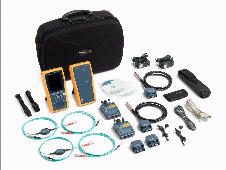Fluke Networks recently launched their new Encircled Flux testing modules. So what is this new testing method all about and why should you care? These questions are answered in this article from Fluke below.
Encircled Flux – What is it, and Why Should You Care? by Bob Violino
With the introduction of low loss fiber optic components such as LC/MPO cassettes, loss budgets (test limits) are becoming increasingly smaller. As a result, installers are finding out that previous methods and assumptions about fiber testing no longer hold true.
While the Telecommunications Industry Association (TIA) still allows 0.75 dB per connector, factory polished connectors are closer to 0.2 dB. So when testing to TIA limits, installers are afforded quite a bit of measurement uncertainty. In other words, their testing practices need to be reasonable but not perfect. 
However, consultants and cabling vendors alike are now starting to specify loss budgets based on component performance, not standards. The allowable slack in testing practices has disappeared. To stay current, installers need to re-evaluate their test equipment and procedures.
Setting a reference through a bulkhead adapter is no longer an option; the reference has to be continuous from the source to the meter using one test reference cord (1 jumper). For some, that means investment in new test equipment and the inevitable training that goes along with it.
The test reference cords must also have reference grade connectors, which ISO/IEC 14763-3 defines as being =0.1 dB for multimode and =0.2 dB for singlemode. When the low-loss cassette has a 0.15 dB LC connector, testing it with anything worse than a 0.15 dB LC connector is going to result in a pessimistic result or potential failure.
While many installers are scrambling to adjust and tune their test procedures, there is one final part to the story in reducing measurement uncertainty, and you may have heard about it already. It’s called Encircled Flux (EF).
If two technicians used the same reference test cords with reference grade connectors along with mandrels, but two different light sources, they might see two different readings. We know from the work within ISO/IEC 14763-3 on measurement uncertainty that this could be in the region of +/- 0.09 dB with the same source.
That’s the nature of fiber testing. The fiber connection is considered random, which is why having a reference grade connector is important. But, if you then use two different light sources, there is additional uncertainty, even though you’ve referenced them out. It’s caused by how the light is launched into the fiber.
Many years ago, the TIA attempted to define this launch though something called Coupled Power Ratio (CPR). It was a good effort but still allowed too much variability in the launch between sources. So in 2010 the TIA and IEC created EF to further tighten down the launch condition.
For those into standards numbers, you need to look to ANSI/TIA-526-14-B or IEC61280-4-2 (they are the same document) for EF. Missing from this standard was how to implement it in the field. Many feel that this is a requirement that belongs in the laboratory, as the current implementation in the field is less than ideal.
As a result, the TIA is working on TIA-TSB-4979 Practical Considerations for Implementation of Multimode Launch Conditions in the Field. There are two methods described in this Telecommunications System Bulletin. One is the less than desirable (not inexpensive) use of a mode conditioner that replaces the mandrel. The other describes an EF compliant source with a device that strips out the unwanted modes.
It seems likely that EF compliance is going to become a requirement in many test specifications in the coming year, so installers might want to keep an eye on developments in the field.
Still want more inforamton? Click here to view the Fiber Optic Encircled Flux Round Robin Testing PDF.


.png?width=58&height=58&name=X_logo_2023_(white).png)
